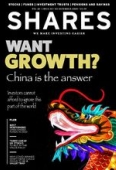Archived article
Please note that tax, investment, pension and ISA rules can change and the information and any views contained in this article may now be inaccurate.
Here’s why gold has sold off, copper has rallied and oil remains volatile

Positive coronavirus vaccine news has overwhelmingly been welcomed by investors with hopes solidifying that our lives and the economy can start getting back to normal next year.
But there is one corner of the market where such upbeat news has triggered a sell-off – gold.
A safe haven asset in times of uncertainty, gold reached all-time highs earlier this year as investor nervousness peaked, but has since declined from highs of around $1,980 per ounce at the end of July to trade around 10% lower at $1,790.

There are a few reasons for this. Firstly, the vaccine news gives some certainty over the global economic recovery, reducing the general risk of stocks and so diminishing the appeal of safe havens like gold.
Secondly, US president-elect Joe Biden has begun announcing his Cabinet and has named Janet Yellen his Treasury secretary. A former chair of the US Federal Reserve, her accommodative policies were positive for riskier markets like stocks and currencies over most of the last decade, also reducing gold’s appeal.
But Yellen’s appointment could have some positives for gold as it potentially raises the chance of interest rates staying lower for longer, with lower interest rates typically benefitting gold.
Finally, Biden now looks to be the clear winner of the US election, with president Donald Trump not conceding but agreeing to have his team transition to the new administration, again removing a barrier of uncertainty.
One commodity gaining traction meanwhile is copper, which has hit four-year highs on the London market, trading at around $7,674 per tonne and up around 12% on a monthly basis.
Copper is an economic bellwether and, as well as Covid-related mine closures affecting supply, its rising price reflects higher demand as economies around the world – particularly in China, the world’s biggest consumer of copper – start to recover.
Investment bank Goldman Sachs is certainly bullish and set a price target of $9,500 a tonne for copper, up from $7,500. It also says it’s ‘highly probable’ that by the first half of 2022 copper could test its record high of $10,170 set in 2011.
It’s also been a big week for oil. A delay in an expected decision by oil producers’ cartel OPEC and Russia to extend production cuts due to expire in January from 30 November to today (3 Dec) will do little to stem volatility in the market.
The organisation faces a tricky balancing act as it eyes a post-Covid reopening of the global economy on which the timing is uncertain. The danger being that if production is increased at a time when demand is still depressed it will put prices under renewed pressure.
Reportedly Saudi Arabia wants to maintain the status quo, Russia is pushing for a phased increase in output, while UAE will only commit to quotas if other OPEC members comply.
Important information:
These articles are provided by Shares magazine which is published by AJ Bell Media, a part of AJ Bell. Shares is not written by AJ Bell.
Shares is provided for your general information and use and is not a personal recommendation to invest. It is not intended to be relied upon by you in making or not making any investment decisions. The investments referred to in these articles will not be suitable for all investors. If in doubt please seek appropriate independent financial advice.
Investors acting on the information in these articles do so at their own risk and AJ Bell Media and its staff do not accept liability for losses suffered by investors as a result of their investment decisions.
Issue contents
Editor's View
First-time Investor
Great Ideas
- 122% in four months: This stunning run for The Panoply should continue
- Primark owner Associated British Foods is well placed for a recovery
- Aviva chief delivers on promise to add shareholder value
- Big transactions at Pets at Home following first half results
- Cheap access to a hot style with a 4.9% yield
Money Matters
News
- Investors warned of tracker flip risk ahead of Tesla’s S&P 500 entry
- Here’s why gold has sold off, copper has rallied and oil remains volatile
- Hipgnosis benefits from change in valuation method
- The companies eyeing Arcadia assets after collapse
- Kingspan ESG credentials clouded by Grenfell inquiry
- Life sciences industry veteran David Evans launches new investment company
- Consequences of the pound rally on certain UK stocks
- Fabric coating Covid killer HeiQ to join UK stock market

 magazine
magazine








